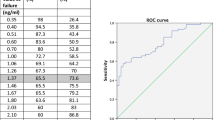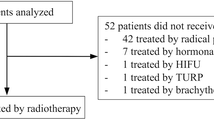Abstract
Purpose
To evaluate the effect of total PSA (tPSA) and PSA kinetics on the detection rates of 11C-Choline PET in patients with biochemical recurrence (BCR) after radical prostatectomy (RP) or external beam radiotherapy (EBRT).
Methods
We included 185 patients with BCR after RP (PSA >0.2 ng/ml) or after EBRT (ASTRO definition). After injection of 400 MBq 11C-Choline i.v., a scan was made using the ECAT HR + PET camera with CT fusion images or Siemens mCT PET/CT. Biopsy-proven histology, confirmative imaging (CT or bone scan) and/or clinical follow-up (PSA) were used as composite reference. Statistical analysis was performed using PASW Statistics 18.
Results
11C-Choline PET was positive in 124/185 cases (65 %) (in 22/61 (36 %) after RP, 102/124 (82 %) after EBRT). In 79 patients a local recurrence was identified, and 45 patients showed locoregional metastases on PET/CT. In 20 cases a proven false-negative PET scan was observed. Positive PET scans were confirmed by histology in 87/124 (70 %) cases, by confirmatory imaging in 34/124 (28 %) and by clinical follow-up after salvage treatment in 3 (2 %) cases. The ROC analysis to detect a recurrence showed significant difference in area under the curve (AUC) of tPSA 0.721(p < 0.001) and PSA velocity 0.730 (p < 0.001). PSA doubling time showed no significant difference with an AUC of 0.542 (p = 0.354). Detection rates are <50 % in tPSA <2 ng/ml and/or PSA velocity <1 ng/ml/year.
Conclusions
Total serum PSA and PSA velocity have significant effect on the detection rates of 11C-Choline PET/CT in men with a BCR after RP or EBRT.
Similar content being viewed by others
References
Jemal A, Siegel R, Ward E, Hao Y, Xu J, Thun MJ (2009) Cancer statistics, 2009. CA Cancer J Clin 59:225–249
Han M, Partin AW, Pound CR, Epstein JI, Walsh PC (2001) Long-term biochemical disease-free and cancer-specific survival following anatomic radical retropubic prostatectomy. The 15-year Johns Hopkins experience. Urol Clin N Am 28:555–565
Agarwal PK, Sadetsky N, Konety BR, Resnick MI, Carroll PR (2008) Cancer of the prostate strategic urological research endeavor (CaPSURE). Treatment failure after primary and salvage therapy for prostate cancer: likelihood, patterns of care, and outcomes. Cancer 112(2):307–314
Breeuwsma AJ, Pruim J, Van Den Bergh AC et al (2010) Detection of local, regional and distant recurrence in patients with PSA relapse after external beam radiotherapy using (11)C-choline positron emission tomography. Int J Radiat Oncol Biol Phys 77:160–164
Maffezzini M, Bossi A, Collette L (2007) Implications of prostate-specific antigen doubling time as indicator of failure after surgery or radiation therapy for prostate cancer. Eur Urol 51:605–613
Palma D, Tyldesley S, Pickles T (2008) Prostate cohort outcomes initiative. Pretreatment prostate-specific antigen velocity is associated with development of distant metastases and prostate cancer mortality in men treated with radiotherapy and androgen-deprivation therapy. Cancer 112:1941–1948
Petit JH, Chen MH, Loffredo M, Sussman B, Renshaw AA, D’Amico AV (2006) Prostate-specific antigen recurrence and mortality after conventional dose radiation therapy in select men with low-risk prostate cancer. Cancer 107:2180–2185
Castellucci P, Fuccio C, Nanni C et al (2009) Influence of trigger PSA and PSA kinetics on 11C-Choline PET/CT detection rate in patients with biochemical relapse after radical prostatectomy. J Nucl Med 50:1394–1400
Giovacchini G, Picchio M, Scattoni V et al (2010) PSA doubling time for prediction of [(11)C]choline PET/CT findings in prostate cancer patients with biochemical failure after radical prostatectomy. Eur J Nucl Med Mol Imaging 37:1106–1116
Fitzpatrick JM, Banu E, Oudard S (2009) Prostate-specific antigen kinetics in localized and advanced prostate cancer. BJU Int 103:578–587
Picchio M, Messa C, Landoni C et al (2003) Value of 11C choline-positron emission tomography for restaging prostate cancer: a comparison with 18F fluorodeoxyglucose-positron emission tomography. J Urol 169:1337–1340
de Jong IJ, Pruim J, Elsinga PH, Vaalburg W, Mensink HJ (2003) 11C-Choline positron emission tomography for the evaluation after treatment of localized prostate cancer. Eur Urol 44:32–38
Rinnab L, Mottaghy FM, Blumstein NM et al (2007) Evaluation of [11C]-choline positron-emission/computed tomography in patients with increasing prostate-specific antigen levels after primary treatment for prostate cancer. BJU Int 100:786–793
Krause BJ, Souvatzoglou M, Tuncel M et al (2008) The detection rate of [(11)C]choline-PET/CT depends on the serum PSA-value in patients with biochemical recurrence of prostate cancer. Eur J Nucl Med Mol Imaging 35:18–23
Consensus Statement (1997) Guidelines for PSA following radiation therapy. American Society for Therapeutic Radiology and Oncology Consensus Panel. Int J Radiat Oncol Biol Phys 37:1035–1041
Hara T (2002) 11C-Choline and 2-deoxy-2-[18F]fluoro-d-glucose in tumor imaging with positron emission tomography. Mol Imaging Biol 4:267–273
Boellaard R, O’Doherty MJ, Weber WA et al (2010) FDG PET and PET/CT: EANM procedure guidelines for tumour PET imaging—version 1.0. Eur J Nucl Med Mol Imaging 37:181–200
Schmid HP, McNeal JE, Stamey TA (1993) Observations on the doubling time of prostate cancer. The use of serial prostate-specific antigen in patients with untreated disease as a measure of increasing cancer volume. Cancer 71:2031–2040
Connolly D, Black A, Murray LJ, Napolitano G, Gavin A, Keane PF (2007) Methods of calculating prostate-specific antigen velocity. Eur Urol 52:1044–1051
Stamey TA, Kabalin JN, McNeal JE et al (1989) Prostate specific antigen in the diagnosis and treatment of adenocarcinoma of the prostate. II. Radical prostatectomy treated patients. J Urol 141:1076–1083
Stamey TA, Johnstone IM, McNeal JE, Lu AY, Yemoto CM (2002) Preoperative serum prostate specific antigen levels between 2 and 22 ng/ml. correlate poorly with post-radical prostatectomy cancer morphology: prostate specific antigen cure rates appear constant between 2 and 9 ng/ml. J Urol 167:103–111
de Jong IJ, Pruim J, Elsinga PH, Vaalburg W, Mensink HJ (2003) Preoperative staging of pelvic lymph nodes in prostate cancer by 11C-choline PET. J Nucl Med 44:331–335
Scattoni V, Picchio M, Suardi N et al (2007) Detection of lymph-node metastases with integrated [11C]choline PET/CT in patients with PSA failure after radical retropubic prostatectomy: results confirmed by open pelvic-retroperitoneal lymphadenectomy. Eur Urol 52:423–429
Conflict of interest
The authors declare that they have no conflicts of interest.
Author information
Authors and Affiliations
Corresponding author
Rights and permissions
About this article
Cite this article
Rybalov, M., Breeuwsma, A.J., Leliveld, A.M. et al. Impact of total PSA, PSA doubling time and PSA velocity on detection rates of 11C-Choline positron emission tomography in recurrent prostate cancer. World J Urol 31, 319–323 (2013). https://doi.org/10.1007/s00345-012-0908-z
Received:
Accepted:
Published:
Issue Date:
DOI: https://doi.org/10.1007/s00345-012-0908-z




